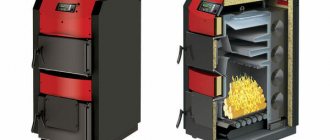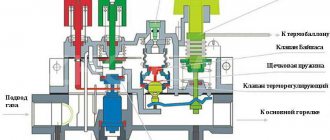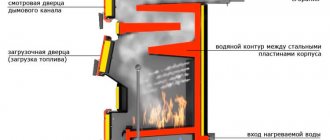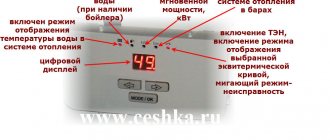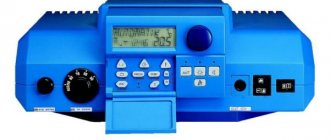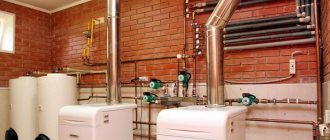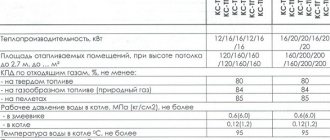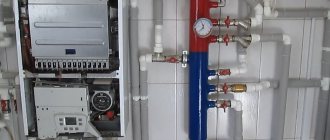But today boilers have begun to be produced in more modernized ways. Now a person will not have to constantly hover around the boiler to throw in a couple of firewood or take out the ashes, nor will he have to check the temperature. The boiler does all this itself, regardless of the person, since now they have automation. This means that a person can only configure the automation as desired, and then he can not interfere with the operation of the boiler. Automation for solid fuel boilers includes a computer for control, as well as a fan turbine, which increases efficiency.
Solid fuel boilers with automatic feed
It is especially worth dwelling on the category of solid fuel heating devices that are equipped with devices and mechanisms that facilitate the work of the fireman. We are talking about a type of boiler equipment such as a solid fuel boiler equipped with an automatic fuel supply mechanism. A number of current heating units are equipped with special devices with the help of which fuel is constantly loaded into the combustion chamber. Such devices are called pellet devices, because pellets go into the firebox - small, flammable granules made from wood waste.
Boilers with automatic fuel supply are considered one of the most efficient. The efficiency in such a device reaches 80-85%, due to the most complete combustion of fuel and automation of the process itself. Such equipment provides the necessary comfort, cleanliness and coziness in the house during operation. Solid fuel is carefully poured into the bunker and from there it is fed by a screw mechanism into the combustion chamber.
Solid fuel heating boilers, in addition to automatic fuel supply, are also equipped with a device that allows you to clean the ash pan without using human hands.
Features, Pros and Cons
The main functions of the automatic control unit include:
- Dosed supply of combustion air.
- Control over the performance of the heat generator.
- Indirect regulation of thermal power depending on the temperature of the coolant.
- Direct control of power relative to the air temperature in the house or weather conditions.
- Ensuring the operation of the water heating installation in a safe mode.
- Automatic fuel supply.
- Ignition and extinguishing of the furnace of the unit.
Positive aspects of using automation:
- indicator has increased .
- There is no need to constantly monitor the combustion process.
- Economical fuel consumption.
- Maintaining a constant temperature in the heating system.
- during operation of the unit increases
- The interval between scheduled inspections is increasing.
- If a part fails , special sensors send a signal to the control unit, and the heating system automatically turns off (stops its operation).
Flaws:
- High price. The presence of additional options for automation significantly affects the price of the device.
- Considering the volatility of the control unit , there is a need to purchase an uninterruptible power supply, or you can use a mechanical traction regulator.
Wall unit electronics
A special feature of these heat generators is electronic control of the processes of ignition, combustion and maintenance of coolant temperature. That is, wall-mounted gas boilers (and some floor-standing ones) are equipped with energy-dependent automation powered by electricity.
An automatic gas boiler was created for maximum convenience for owners of apartments and private houses. To start the heater, just press 1 button and set the desired temperature. Let us briefly describe the operating algorithm of the unit and the elements involved in it:
- After these startup steps, the heat generator controller collects sensor readings: coolant and air temperature, gas and water pressure in the system, and checks the presence of draft in the chimney.
- If everything is in order, the electronic board supplies voltage to the electromagnetic gas valve and at the same time a discharge to the ignition electrodes. The wick is missing.
- The main burner ignites and gives full power in order to heat the coolant as quickly as possible. Its operation is monitored by a special flame sensor. The controller includes a built-in circulation pump.
- When the coolant temperature approaches the set threshold, which is recorded by the overhead sensor, the combustion intensity will decrease. Staged burners switch to low power mode, and modulating burners smoothly reduce the fuel supply.
- Having reached the heating threshold, the electronics will shut off the gas. When the sensor detects cooling of the water in the system, automatic ignition and heating will be repeated.
The instructions for the wall-mounted gas boiler indicate that the unit is designed to operate in a closed heating system, so the automation monitors the water pressure. If it drops below the permissible limit (0.8-1 Bar), the burner will go out and will not light until the problem is corrected.
Many imported boilers operate according to an energy-dependent scheme, for example, Buderus Logano, Viessmann and so on. How the installation of electronic gas equipment occurs, the master will tell you in an accessible language in the video:
Watch this video on YouTube
Features of installing automation on the boiler
The installation of automation on a solid fuel boiler should be carried out by a professional technician. The procedure has quite a few nuances that must be taken into account. Incorrect installation will make it impossible for the unit to function normally and all efforts to replace the control unit will be in vain. The cost of the service is very low, so you won’t be able to save a lot of money on this. But the damage from incorrect actions and subsequent breakdown will be noticeable.
After completing installation work, correct calibration must be carried out. You can do this yourself using the included instructions, or seek help from the specialist who carried out the installation. The automation for the boiler is configured according to the following scheme:
- 1. First, you need to fill the heating system with coolant and bleed all the air out of it so that there are no plugs that will interfere with normal circulation. It won't be difficult at all to do this.
- 2. Then you need to start the circulation pump and check that it begins to drive water through the system without any obstacles.
- 3. When the water in the system begins to circulate, you need to check the readings on all emergency thermostats, as well as the water level and its pressure in the system. All indicators must be within acceptable limits.
- 4. Now you can proceed directly to ignition. Each automation has its own characteristics of starting the flame into the combustion chamber, so at this stage you must strictly adhere to the requirements of the operating instructions.
- 5. When ignition is completed, you need to add the specified amount of fuel into the firebox and set the desired operating parameters. Occasionally you will need to add fuel and check the readings of control devices with the norm.
The best known manufacturers and models: characteristics and prices
ATOS + WPA 120
One of the best and most common automation kits for solid fuel heating boilers.
The ATOS controller is distinguished by extremely wide functionality, a considerable number of customizable operating parameters and an affordable price. In addition to standard functions, there is: protection against freezing of the heating system; notification of temperature drop or overheating, lack of fuel; LED indicators of circulation pump and fan operation; adjustable hysteresis. It is also known for its reliability due to operational practice. Manufacturer: KOM-STER, Poland.
Blower fan M+M WPA 120 is also the most common, time-tested Polish model. Designed to work with boilers with a power of 25-50 kW. There are other versions on the market for more or less powerful boilers.
Cost of the set: 8,900-10,000 rubles.
COMFORT-ECO + NWS-100
The controller is another Polish model: with almost the same functionality and reliability for an even more modest price. Functionality implies the presence of all safety functions, the ability to connect a room thermostat and outdoor sensors, control of a circulation pump (but not DHW). It features a fail-safe filter and an overload fuse.
The Nowosolar NWS-100 turbine is a simple Polish aluminum model, one of the most inexpensive on the market. It has an unremarkable standard design, known for high-quality assembly and reliability. The model is designed for installation in boilers with a power of 30-50 kW.
Cost of the set: 8,500-9,800 rubles.
Tech ST24 + WPA 120
The controller is a hassle-free, simpler model, equipped only with standard functions: control of the boost fan speed, control of the circulation pump, LED indication of the operation of the elements. Installation of external sensors and automatic feeding systems is also not provided. An excellent choice, but at a price comparable to more functional models. The fan is the most common model already described above.
Cost of the set: 9,200-10,500 rubles.
KG Elektronik CS-18S + DP-120
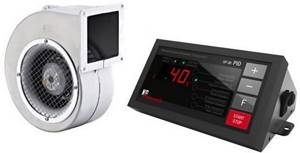
The Polish controller KG Elektronik CS-18S is one of the most modern and functional on the market. It is distinguished by the presence of a touch screen control, the ability to control the fan, circulation pump, hot water supply, and automatic supply system. The DHW pump can be made a priority; there are also special modes adapted for each type of fuel: wood, wood and coal, coal, sawdust. All existing protective mechanisms are also provided: against overheating and freezing, stopping the circulation pump.
The KG Elektronik CS-18S + DP-120 fan is also one of the best. It features an asynchronous motor and high performance with a relatively low noise level of up to 63-65 dB. It has a metal damper at the outlet that blocks the reverse flow of exhaust gases.
Cost of the set: 11,000-12,500 rubles.
Price and reviews
The cost of an automated system is influenced by the technical indicators and functionality of the device. Thus, the price of the simplest mechanical model varies within 1.5 thousand rubles.
The price range of more progressive options is from 25,000 rubles to 100,000 rubles. The more expensive the model, the higher the ergonomics of the heating system will be, and the resource consumption will be correspondingly lower. Therefore, it is more advisable to give preference to more expensive options.
Reviews:
Nikolai Viktorovich. “The control unit from the Krypton company is one of the best devices today. It is distinguished by the quality of its components; the kit includes a sensor, cords for connecting to the fan and pump, a clamp, and adapters. A reliable device from a Polish manufacturer.”
Fedor. “On the recommendation of a friend, I installed the ATOS automatic, its performance characteristics are excellent.”
Anatoly Yurievich. “The Proton automation surprised me with the presence of additional components in the package (a clamp for attaching the sensor, a stand for the unit, self-tapping screws). The device is efficient, reliable and easy to use. ”
Automatic control - safe and reliable!
Boilers with automation are not inferior to gas and even electric models. It can be installed even on a simple device that is already in use. However, each automatic device should be selected very carefully, checking its compatibility.
A boiler without automation requires a fairly responsible attitude from the owner, a lot of attention and is an unsafe device.
Automation brings heating devices to a safety standard - correctly selected and installed devices ensure stable operation, uniform heating and a guarantee of peace and warmth in the home of its owner.
Kinds
Automation for solid fuel units can be classified according to autonomy.
There are two types here:
- Automation that does not require electricity.
- Automation powered by electricity. This type performs all its functions only if it is connected to a power source. Of course, it is also equipped with a backup reserve if the power supply is suddenly interrupted. So, even if the electricity supply is interrupted, the boiler will continue to work for some time.
Of these two options, it is the second option that is recommended, since it has a large number of diverse functions and effectively fulfills its obligations.
What types of automation are there?
The capabilities of modern electronic devices included in the set of equipment for controlling the operation of a heating device are quite wide, allowing you to configure the devices in accordance with your own priorities and desires. In most cases, the set of modern complex heating devices includes:
- a computer that controls the heating device;
- fan or air turbine.
Today it is possible to equip conventional semi-automatic solid fuel units of almost any type with an automatic control unit of the Comfort Eco type. A semi-automatic solid fuel boiler equipped with such a kit can already perform most of the processes independently. Sensors regulate the heating temperature of the coolant and the state of draft. All information appears on the screen. A conventional or long-burning unit with automation becomes an order of magnitude more convenient to use and safer.
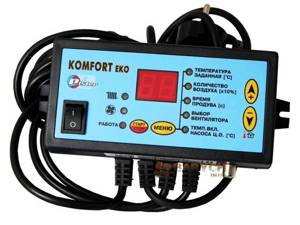
If everything is more or less clear with electronics, then the mechanical part should be dealt with in more detail. There is a classification of automation in terms of autonomy. In this case, it is customary to distinguish:
- automation, energy-dependent - powered by electricity;
- automation, non-volatile, which does not require connection to the electrical network.
In the first case, the operability of the main devices is only possible when the devices are connected to the power supply. To increase the safety of such devices, the autonomous heating system is equipped with a UPS. The first option looks preferable, since network-powered automation has greater functionality.
The second case is focused on greater autonomy. Such options are very convenient in situations where there are frequent power outages, and the heating device is configured to work independently without unnecessary electronics.
Types and advantages of automatic devices for gas boilers
The automatic control unit for a gas boiler can operate autonomously or from the network
Automation for a gas boiler is traditionally classified according to the degree of its dependence on the energy supply. According to this feature, they distinguish:
- volatile systems that operate only when electricity is available;
- non-volatile electronics that do not require connection to the electrical network.
The second option usually uses a backup UPS. Many users prefer power-dependent systems because they have greater functionality. The second option for powering automatic heating systems is relevant for situations where there are constant power outages in a particular area, and the device itself operates reliably from simple electronics.
The advantages of automatic gas boilers as controlled units include:
- the ability to maintain the temperature in heating circuits at a fixed level without human intervention;
- ability to work in automatic mode for a long time (up to 48 hours);
- the presence of an automatic ignition system for solid and gas fuels;
- limiting operator intervention in controlling a floor-standing or wall-mounted boiler.
The user just needs to set a certain temperature regime, which is constantly maintained within the living space.
An important advantage of gas heating boilers equipped with automatic equipment is independence in critical operating conditions. In case of urgent shutdown, there is no need to wait for it to cool completely.
There is no need to drain the coolant for fear of defrosting the system. Automation will perform all these operations at the command of the owner who is not within the house. Using telephone-controlled electronics, you can set the required operating mode of the gas boiler and, if desired, optimize it.
Connecting the thermostat

When connecting a conventional thermostat to the boiler (as an element of automation), operating comfort increases and gas consumption is reduced. This occurs due to the fact that the boiler is controlled by a sensor installed in the thermostat itself and turns off the burner when the set air temperature is reached in the room.
Taking into account the fact that the volume of air in the room is several times (or even tens of times) greater than the volume of the coolant, its cooling rate is several times lower than the rate of temperature drop in the boiler.
However, in this operating mode it is impossible to adjust the coolant temperature using the thermostat itself. Therefore, the value on the boiler is most often set to the calculated maximum. This is done to ensure that the boiler reaches the set temperature as quickly as possible. However, this method has one negative side. The media temperature either rises to maximum or drops almost to room temperature during idle time. During the off-season, this can lead to uncomfortable sensations. The radiator is either cold or hot - this is not very convenient.
How to make simple automation with your own hands: tips and tricks
It’s not difficult to set up the simplest automatic control of a solid fuel boiler with your own hands. The most important thing here is to buy the right equipment. You understand that you will not be able to make all the necessary devices, and the equipment itself, by and large, does not cost that much. That is why, when talking about homemade automation for a solid fuel boiler, in most cases we mean buying ready-made equipment and installing it yourself. Do-it-yourself installation is quite simple, and you can imagine this whole process in the form of the following sequence of work.
- Fan installation. This is the most difficult part of the work, especially if the boiler design does not provide for automatic control. In such a situation, you will have to make a hole for air injection yourself and install a turbine on it. In principle, this is not difficult for a technically competent person - the main thing here is not to forget about the heat-resistant seal between the fan and the door, and everything else is trivial. The fan is screwed into place through pre-drilled holes in the blower door.
- Connecting the controller. There is also nothing complicated here - when purchasing an automation kit, you are buying some semblance of a construction set, which is assembled according to the scheme. No exception is the switching of wires, which, among other things, are equipped with connectors that cannot be confused.
When the automation is assembled, there is only one thing left to do - install a temperature sensor. As a rule, in almost all models of modern solid fuel boilers a special place is provided for it. If this is not available, then you can attach the sensor directly to the supply pipeline - in the simplest version, this is done using metallized heat-resistant tape. The sensor is simply wound onto the pipe.
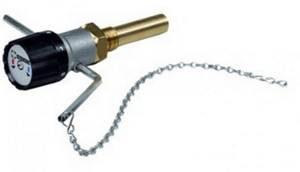
Homemade automation for a solid fuel boiler photo
This concerns the electronic control of a solid fuel boiler. But besides this, there are also mechanical systems that regulate the intensity of fuel combustion by simply opening and closing the boiler ash door. How such automatic control works is, one might say, quite simple. A mechanical thermoelement is installed in the boiler (in a specially designated place) - when heated, the plate built into it changes its shape and configuration, which sets a special lever in motion. In turn, this lever is connected to the ash door by a cable or chain, which transmits the movement of the lever directly to the door, as a result of which it opens and closes, depending on the temperature of the coolant in the boiler.
Which automation is better for solid fuel boilers? Mechanical or electronic? Both principles of controlling fuel combustion in a boiler have their drawbacks. Electronic systems do not work without electricity - in order to ensure the operation of the boiler during power outages, you will additionally have to purchase an uninterruptible power supply unit. The mechanics often jam. In addition, the choice of one or another automation system for a solid fuel boiler can also be influenced by its cost - mechanics will cost less.
Automation for coal boiler
The capabilities of the devices are quite wide. Often, sets of heating devices include: a computer that controls the device, a fan or an air turbine.
The advantage of equipment equipped with automation for heating a private home is considered to be a huge saving of precious minutes and money. After all, innovative long-burning boilers can do almost all the work for you - they can work without human intervention for quite a long time - up to approximately 48 hours! The home owner only needs to set the desired degree level, and the device will carry out the actions independently. In addition, you can set a timer for temperature mode. That is, for example, if the owner of the home leaves it for a certain amount of time, the minimum temperature regime will be maintained. When the tenant arrives, the timer will go off and the home will begin to warm up again to the desired temperature - without human intervention! So, upon arrival, your accommodation will be comfortable and warm.
It is important to note that boilers with automation have become so developed that they are able to independently carry out diagnostics - a safety check, which is a very significant plus
Boilers with automatic feed
Today they are considered the most efficient installation - after all, the efficiency reaches 80-85%! This unit will definitely provide home comfort. The fuel is poured into the bunker and from there it is supplied automatically to the combustion chamber. There is also an addition that allows you to empty the ash pan automatically - without human intervention. The process of installing boilers is a very painstaking work, so saving is not worth it for your benefit.
The main functions assigned to automation
Before installing a solid fuel boiler, you should carefully study the principle of its operation and control mechanisms. Studying the processes of the operating cycle of a heating device will allow you to understand how the devices and mechanisms that control the heating system work. What is automation for solid fuel boilers today, and what are its main functions.
The automation is assigned the following functional tasks:
- ensuring optimal temperature conditions in the heating circuit;
- performing a monitoring function over the operation of the pump and three-way valve in the mixture circuit;
- ensuring control over the operation of the circulation pump on the main heating circuit;
- control of water heating temperature in the DHW system;
- provide switching on/off of the three-way valve;
- boiler equipment automation is a set of equipment together with a room thermostat.
The diagram shows the usual wiring of an autonomous heating system with installed automation.

*
Automation of many processes when operating heating devices using solid fuel makes it possible to achieve significant savings in fuel resources and free the inhabitants of the house from the function of a stoker. Today, automation is a set of complex and energy-intensive devices, each of which solves a specific range of problems and issues.
An automatic boiler is a unit that is capable of operating entirely autonomously, from adding fuel to adjusting the heating temperature.
For reference: All processes, starting with fuel loading, ignition and control over turning on and off, are done automatically. Without your participation. The presence of sensors and controllers allows the system to respond to a changing situation. Based on the parameters you set, the boiler operates in the set modes.
Automation from different manufacturers
Wall-mounted gas boiler
If we talk about a standard wall-mounted gas boiler, then it can operate according to the coolant temperature. A room thermostat or chronothermostat can be connected to it. It is also possible to connect an openterm protocol regulator.
A special case of using wall-mounted boilers is the possibility of using weather-dependent automation. Due to the use of an external temperature sensor, additional variables appear that make it possible to more quickly adjust the burner power and supply temperature, depending on the changing conditions outside the building.
Automation Arbat
The devices have 5 degrees of protection. There is thermoelectric flame protection. The gas supply is blocked when switched off. A modulating thermostat will provide comfort in use, and a coarse mesh filter will extend its service life.
Some models are equipped with a circulation pump. The device distributes the coolant evenly throughout the heating system. It is also possible to connect to an external thermostat inside or outside the room.
Automation Honeywell
Honeywell has a wide range of automation systems for gas boilers, from the most budget (mechanical) to multifunctional automatic systems.
Main features:
- the coolant automatically maintains the temperature;
- turning off the boiler in case of gas supply interruptions;
- shutdown in the absence of draft or during reverse draft;
- blocking the gas supply when the gas burner goes out.
Some models are equipped with programmable automation with the ability to set temperature periods depending on the time of day, weather, and even develop a heating/cooling mode by day of the week. And the Smile series models control several temperature circuits at once (heating, ventilation, “warm floor”, hot water, etc.).
Automation Eurosit 630 (Eurosit 630)
The Eurosit gas valve is one of the most used. It can be found on both domestic and imported boilers. Main advantages: multifunctionality of the gas supply regulator, modulation thermostat and the function of full modulation switching on the main burner. It works both from liquefied fuel cylinders and from a gas tank, without the use of electricity. Used in various types of gas-consuming equipment that require precise temperature control.
Basic principles of operation of Eurosit 630 automation.
Ignition of the pilot burner.
- Check that the knob position matches the “off” icon.
- Move the control knob to the “asterisk” position.
- Keep the control knob pressed for a few seconds. Then release and make sure the pilot burner turns on. If the pilot burner goes out, repeat step 3.
Temperature selection.
Use the control knob to set the temperature. The gas will begin to flow into the main burner, where it will be ignited using the pilot burner.
Power modulation.
The thermostatic system regulates gas flow and gas pressure in the main burner depending on the system capillary sensor. The colder the sensor, the greater the power and vice versa. The graph schematically shows how the power changes from maximum to minimum and then until the burner is completely turned off.
Duty position.
Move the control knob from the set temperature to “asterisk”. The main burner will go out, but the pilot burner will remain lit.
Shutdown.
Set the knob to the off position. The valve will close completely, but the thermoelectric protection magnet will remain temporarily activated until the thermocouple sensor cools down. During this period of time, restarting of the thermoelectric system is mechanically prevented. The function is called "interlog". It ensures ventilation of the combustion chamber before the next burner start-up.
Automatic blocks of floor-standing boilers
The vast majority of floor-standing gas boilers are equipped with automatic safety systems that operate without an external power source (non-volatile). According to the requirements of regulatory documents, automation equipment must shut off the gas supply to the burner and igniter in three emergency cases:
- Extinction of the main burner flame due to blowing out or for other reasons.
- When natural draft in the chimney channel is absent or sharply reduced.
- The drop in natural gas pressure in the main pipeline is below a critical level.

For reference. The implementation of the listed functions is mandatory for gas boilers of all types. Many manufacturers add a fourth level of safety – overheating protection. When the coolant temperature reaches 90 °C, the valve, based on a signal from the sensor, stops supplying gas to the main burner.
Various models of gas floor-standing boilers from different manufacturers use the following types (brands) of non-volatile automation:
- Italian blocks EuroSIT (Eurosit) series 630, 710 and 820 NOVA (heating units Lemax, Zhitomir 3, Aton and many others);
- Polish devices "KARE" (heat generators "Danko", "Rivneterm");
- American automatic control devices Honeywell (Zhukovsky heaters);
- domestic products, "Arbat".
Functions and principle of operation of security automation
According to regulatory documentation, the safety system of automatic gas boilers must consist of equipment that will turn off the system, shutting off the gas in the event of any breakdown. Thus, automation monitors a number of indicators
:
- Gas pressure. When it drops to a critical point, the fuel supply stops. The action occurs automatically due to the valve mechanism, which is set to a certain value. In volatile devices, the maximum/minimum pressure switch is responsible for monitoring. The membrane with the rod bends as the number of atmospheres increases, as a result of which the boiler power contacts open.
- Is there a flame in the burner? In its absence, the thermocouple cools down, stopping producing current. As a result, the gas valve solenoid valve does not work and gas is not supplied.
- Presence of traction. When it decreases, the bimetallic plate heats up and changes shape, so the valve stops the fuel supply.
- Coolant temperature. The thermostat is necessary to maintain the temperature set by the user, preventing the system from overheating.
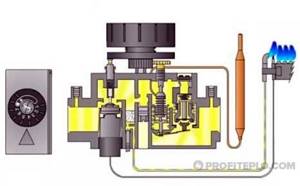
Schematic diagram of the operation of the automation regulator
The result of these malfunctions may be the main burner turning off and the room becoming gassed, which is absolutely not allowed. Therefore, automation must be present on all gas boilers without exception, especially on old-style equipment, where this design was not provided by the manufacturer.
The functioning of the electronic system is based on receiving information from sensors. It is analyzed by the controller and microprocessor. After processing the data, certain commands are sent to the drives of the unit.
The operating principle of the mechanics is different. When the boiler is switched off, the gas valve is closed. Starting the unit involves squeezing the washer on the valve, as a result of which it opens in forced mode and fuel flows to the igniter. Its ignition leads to heating of the thermocouple and the generation of voltage on it necessary for the operation of the electromagnet. He, in turn, keeps the valve open. By turning the washer, you can adjust the boiler power.
Design and operating principle
The automation that controls the operation of a gas boiler consists of many elements, conditionally divided into two subgroups. The first includes mechanisms that ensure the full and safe functioning of the boiler itself. The second includes devices that make it possible to operate the heating system in the most convenient and user-friendly mode.
Components of a security system
Several modules are responsible for the operational safety of the unit:
- Flame controller - consists of two main parts - a solenoid valve and a thermocouple. Shuts off gas promptly and reliably and prevents leakage.
- Thermostat - maintains the set temperature of the coolant and protects the system from overheating. When the coolant cools down to minimum temperatures, the module starts the boiler into operation, and after recording peak-high readings, it turns it off, completely relieving the owners of the need to constantly pay attention to the system.
- The draft control sensor is responsible for stopping the gas supply to the burner in the event of a change in the basic position of the bimetallic plate, thus preventing gas leakage.
- Safety valve - monitors the amount of coolant in the circuit.
In addition to all the above useful qualities, the automation has a number of additional functions that increase the comfort of using the equipment.
The device performs automatic ignition of the gas burner, selects the most effective operating mode, promotes rational consumption of energy resources and conducts independent diagnostics, saving the owners from all these activities.
Operating principle of security automation
Current regulatory documentation says that the safety system for gas boilers must be equipped with a device that stops the operation of the entire system and shuts off the gas supply in the event of an unexpected breakdown or any other force majeure circumstances.
How to set up controls yourself
Basic setup steps:
- Debugging of water supply systems, hot and cold. The safety manual is used as instructions and the safety valve and pressure regulator are checked.
- For a gas boiler, the gas train on the burner is checked. First, everything is checked without ignition, at minimum power, then at medium and at maximum.
If it works without failures, you can set it to automatic mode.
- Pressure and temperature sensors are calibrated. The operation of the sensors is checked in two modes: emergency and automatic.
The system then runs for 72 hours. If it works without deviations, the setup can be considered successful.
If necessary, the automation can be reconfigured; this requires a wrench and a screwdriver. The cover of the device is removed, changes are made to the range of permissible values (when the device operates), the pressure increases or decreases.
If the pressure changes after connecting the device to the network, new values will be displayed on the pressure gauge.
It is better to regulate the temperature in the premises directly on site by installing sensors. On the boiler you can adjust the degree of heating of the coolant.
To properly adjust the temperature in the rooms, a thermostat is purchased and installed, which allows programming with a cycle of up to a week and control of the boiler via a mobile phone through a special application.
Important! It is better to entrust the installation of automatic devices to professionals, especially when the boiler is gas. If you have the knowledge and skills, you can configure it yourself
Automation installation
*
If you can install the boiler and lay the pipeline for the autonomous heating system yourself, then when equipping the heating device with control and automation devices, the services of a specialist will be required. Automation for solid fuel boilers requires careful and precise adjustment. The process of installing and directly configuring the equipment is complex and painstaking. Therefore, saving in this case is not worth it.

The first thing that specialists pay attention to when starting installation of equipment is the installation of a ventilation system, the basis of which is a fan. The equipment is installed at the bottom of the heating device, in the place where a conventional damper is located. The fan is attached firmly enough so that it does not get torn out of place during operation. The next step is installing the controller. For a wood-burning boiler, such a device will be a real godsend. Typically, the controller is a heating unit control unit, which automatically contains various operating algorithms. The main thing here is to correctly place the sensors and make adjustments. After setup, the system is connected to the power supply, and the first test run of the heating device is made.
Connecting an analogue modulating controller
Another possibility for operating boilers is to use, together with the boiler, not a disconnecting thermostat, but an analogue smooth-action regulator. This allows you to control not only the room temperature, but also adjust the burner power due to feedback. Communication with the gas boiler automation is carried out via a wired or wireless line. It becomes possible to track various parameters that depend on a specific model.
Since this will already be an electronic device, it often immediately becomes possible to control the chronoprofile, that is, heating periods and waiting periods for the boiler are set. You can set several different temperature levels.
Smoke exhauster for boiler installation
As noted above, natural draft does not always make fuel combustion and exhaust gas removal ideal. This happens for many reasons, the most common of which are: weather conditions and lack of air flow. If air flow can be created by simply opening the windows, then it is impossible for an ordinary person to change the air temperature in the summer. In order not to depend on the draft in the chimney, users install a device called a smoke exhauster into the smoke removal system. In addition, the use of a smoke exhauster allows less solid soot particles to settle on the walls of the chimney, and, accordingly, less need to resort to the services of a chimney sweep.
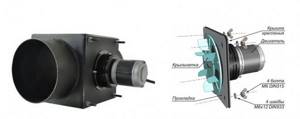
This is an exhaust fan mounted in a metal unit, which is mounted between the boiler and the mouth of the chimney. The picture shows the design of the exhaust fan.
Installing smoke exhausters for household solid fuel boilers with your own hands is quite simple:
- Install the unit at the installation site of the smoke exhauster. For tightness, apply heat-resistant sealant to the joints.
- Place the fan housing on the 4 studs with the impeller facing inward. Make sure that the gasket fits tightly to the exhaust fan mounting unit.
- Place washers and nuts on the studs and tighten the fan assembly evenly.
- Ground the device and connect the power plug to it.
Advice: to avoid electric shock, it is recommended to entrust all work on connecting the device to the electrical network to an electrician with the appropriate work permit.
Types of automation
Depending on the operating principle and design features, automation for gas heating boilers can be one of the following types:
:
- Volatile.
- Non-volatile.
Energy-dependent automation devices
These devices are small electronic devices that respond to the gas supply by opening/closing a tap. The device is structurally complex.
Problems that electronic boiler automation allows you to solve
:
- Close/open the gas supply valve.
- Start the system in automatic mode.
- Adjust the burner power thanks to the presence of a temperature sensor.
- Turn off the boiler in emergency cases or within the specified operating mode.
- A visual demonstration of how the unit works (what temperature is maintained in the room, to what point the water is heated, and so on).

Electronic boiler automation
Due to the constant growth of consumer demands regarding ease of use, manufacturers of modern devices offer a number of additional features:
- Management and control of equipment operation.
- Protection of the heating system against malfunction of the three-way valve.
- Protection of the system from freezing. In this case, the device starts the boiler when the room temperature drops sharply.
- Self-diagnosis in order to identify faulty spare parts and malfunctions of structural elements. This option allows you to avoid breakdowns that could disable the boiler, and, consequently, large material costs associated with major repairs or replacement of equipment.
Thus, electronic safety automatics for gas boilers ensures smooth operation of the equipment when:
- no jumps;
- the specified temperature regime is strictly observed;
- no other problems arise during long-term operation.
Today, the market offers a wide range of energy-dependent automation. It can be either with or without programming capabilities. In the first case, you can configure the system to operate in day-night mode or set different temperature conditions for days 1-7, taking into account the weather forecast.
Non-volatile devices
This type of automatic equipment for controlling the operation of gas heating boilers is mechanical. And many consumers prefer it.
Main reasons
:
- Low price.
- Manual setup, characterized by simplicity, makes it easy for people who are far from technology to operate the device.
- Autonomous device that does not require electricity to operate.
Manual setup is as follows
:
- Each device is equipped with a temperature scale from minimum value to maximum value. By selecting the desired mark on the scale, you set the operating temperature of the boiler.
- After starting the unit, the thermostat takes over, controlling the set temperature by opening/closing the gas supply valve.
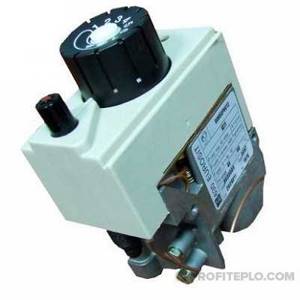
Manual regulator for heating boiler automation
The principle of operation is based on the fact that the gas boiler thermocouple, which is built into the heat exchanger, is equipped with a special rod. The part is made of a special material (an alloy of iron and nickel - Invar), which quickly responds to temperature changes. Depending on the increase or decrease in temperature, the rod changes its size. The part is firmly connected to the valve, which regulates the gas supply to the burner.
But besides this, today’s automation for a non-volatile gas boiler is additionally equipped with draft and flame sensors. They will immediately stop supplying fuel if there is a sharp drop in draft in the chimney or as a result of a decrease in pressure in the pipe.
A special thin plate is responsible for the operation of the flame sensor, which is in a bent state during normal operation of the system. This keeps the valve in the “Open” position. As the flame decreases, the plate straightens, causing the valve to close. The same principle of operation applies to the traction sensor.
Principle of operation
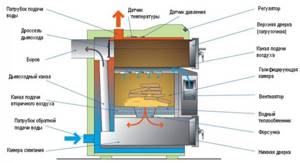
Operating principle of a solid fuel boiler
If in older models of solid fuel units, to regulate the air supply, it was necessary to open or close the ash door manually, and monitor the temperature visually using a thermometer, then in new boilers an automatic draft regulator is installed. This device is energy-dependent; its functions include opening and closing the ash pan damper depending on the temperature of the water in the container.
Taking into account the inaccuracy of the settings and the dependence of the operation of the unit on natural draft in the chimney, instead of an ineffective thermostat, a fan was installed to supply the required volume of air to the combustion chamber. And the operation of the fan is ensured by a controller that receives information about the state of the coolant from the sensor.
The controller consists of a screen and a control panel, designed to set the required coolant temperature. Models that do not have such a kit can be equipped with it; the fan is installed on the mounting plate, but you must first disconnect the ash door.
The coolant temperature is adjusted regardless of external conditions.
To maintain the temperature in the room taking into account street conditions, you can install an additional automatic system with an expanded range of capabilities: remote temperature controllers, outdoor air sensor.
Both wired and wireless methods are suitable for connecting them. Thanks to the information received from the sensors, the selected temperature regime in the house is maintained. This is the most rational method.
Safety valve
Modern automatic models have an ignition system, flame control, and continuous fuel supply. For ignition, an electric incandescent element is provided, which turns on after the pellet screw container is fed into the burner.
A stable flame, recorded by a photosensor in the form of a pulse transmitted to the controller, is a signal to turn off the electric ignition. During operation, granules are fed into the auger from a bunker, the volume of which is capable of providing heat to the room for several days, without human intervention.
Solid fuel units with an automatic control system, in addition to the above devices, are also equipped with safety devices, in particular, a safety valve.
It is necessary to discharge water from the boiler tank in case of overheating, to stabilize pressure, and also provides reliable protection of the casing from destruction. The boiler can be equipped with an overheating sensor, which signals if the temperature is exceeded at the initial stage.
So, boilers can be equipped with:
- Traction control sensor.
- Water level sensors in the jacket.
- Fan - smoke exhauster.
- Pressure recorders.
- Circulation pump.
- Fuel and water consumption sensor for domestic hot water.
- Sensors for the level of pellets or coal in the container.
All these devices are interconnected with a controller that performs control and signals emergency situations. The most sophisticated devices have a remote control function, where you can control automation via the Internet and mobile applications.
Advantages of boiler equipment equipped with automation
The first thing that any heating equipment owner draws attention to is the ability of the heating device to independently regulate the heating temperature of the main heating circuit. Previously, everything was done manually
I closed the damper, the temperature began to drop, and vice versa, I opened the vent, the boiler began to work more intensely, and the temperature rose.
Modern automatic long-burning solid fuel boilers are capable of operating without human intervention for a long time (up to 48 hours), independently regulating all processes
It is only important for you to set the required temperature conditions inside the living space. Thermal sensors react to changes in room temperature by sending a signal to the central automation control panel
From there, a command is sent to turn on special supercharging fans, which provide the combustion process with air.
The next important advantage that automation gives to solid fuel boilers is the independence of the heating device in operation. Now there is no need to turn off the boiler when leaving and wait for it to completely cool down; the heating system must be drained so that it does not defrost
Today the situation has changed radically. Using automation, you can adjust the operation of the heating unit in the minimum (maintenance) mode. In other words: You set your boiler to a specific temperature. While you are not at home, the boiler works to maintain minimum temperatures in the system. In order for the heating device to start at maximum speed, it is enough to set a timer. You arrive, and your house is warm.
In the case of arson of solid fuel, the situation is generally simplified. A person is absolutely not needed for this. At the specified time, the electric ignition will work and the boiler will start working.
The main emphasis in the latest models is on achieving the safest operating mode. Solid fuel units equipped with automatic monitoring devices are capable of regularly conducting self-diagnosis, identifying malfunctions in the operation of one or another element. For a solid fuel boiler, fast response remains important. The faster the devices and the system react to an emergency situation, an increase in pressure in the system, a sharp jump in temperature, the faster the system will stop in automatic mode.
Advantages provided by an automation kit for a solid fuel boiler
There are no accidents or coincidences in our world, and people had to automate the process of burning solid fuel in a heating boiler for a reason - there are a number of good reasons for this.
The most important of them is safety. Anyone who uses solid fuel to heat a home probably knows the consequences of overheating the coolant - boiling water in the boiler can even lead to an explosion with serious consequences. First of all, automatic control allows you to control exactly this moment - a person is a forgetful creature by nature, and automation works according to a program, and there is no such thing as “forgetting” for it. In addition, automation of a solid fuel boiler provides a number of other benefits to humans.
- Optimizing the climate inside the house. It eliminates sudden changes in temperature - when the boiler is just loaded and combustion reaches its peak, the house is hot, and when the firebox is empty, the house becomes cold. Automation removes the first rise in temperature towards an increase.
- Fuel economy. This occurs due to the operation of the thermostat. Having brought the temperature of the coolant to the set value, the automation stops burning, switching the boiler to smoldering mode - slow heating occurs, which consumes much less fuel.
- The task of controlling the combustion process is removed from the person. That is, you loaded the firebox full and went about your business - all that remains is not to miss the next loading of the boiler.
This concerns the primary tasks that automation for a solid fuel boiler is designed to solve. In addition to them, depending on its complexity, automatic control of fuel combustion may have additional options that expand the capabilities.
The principle of operation of volatile and non-volatile heating systems
All devices installed to control the operating processes of the system are divided into volatile (electronic) and non-volatile (mechanical).
Mechanical ones are cheaper, are very simply designed and do not require electricity. The basic principle is to change the size or position of a structural element that is sensitive to changes in temperature or pressure. In accordance with this, the gas supply, coolant flow intensity, and other system operating parameters are reduced or increased.
Volatile automatic devices are controlled by a microprocessor, the valves are activated based on data processing.
The system operating modes required by the user are set on the device display.
Reference! Electronic devices can be duplicated with mechanical ones, then a breakdown in the electronics will not affect the operation of the heating device. This is especially true if there are long periods without light.
How to connect a gas boiler to the heating system?
There are two large types and heating schemes:
- Open single-pipe.
- Closed single-pipe/double-pipe.
Let's look at them in more detail for a better understanding.
Open one-pipe circuit
With this scheme, the expansion tank is actually open - it is in direct contact with the surrounding atmosphere. In the classic piping scheme, the boiler is located at the bottom and the tank is as high as possible. And the greater the height difference between the tank and the upper heating radiator, the better.
The big advantage (and at the same time disadvantage) of this scheme is the natural movement of the coolant. It moves due to the force of gravity. When it cools, it goes down, and when heated in the boiler it rises up again.
The open single-pipe circuit has two undeniable advantages:
- it is the easiest to implement - you can even do it yourself;
- The heating system does not require electricity to operate - the coolant moves independently.
Plus, this is the cheapest option, which remains a decisive factor for many. It also has disadvantages: fairly rapid cooling of the coolant in cold weather, its circulation is not fast enough, difference in radiator temperatures, etc. In addition, the coolant in an open circuit is constantly in contact with oxygen. This provokes the occurrence of corrosion processes in pipelines.
Closed 1-pipe circuit
In this case, the circulation of the coolant is forced, which guarantees a higher speed and uniform heating of the radiators
In addition, it does not matter how the tank is located relative to the boiler. But usually they are placed side by side - so as not to take up extra space in two different rooms
The advantages of a closed system are obvious:
- cleaner coolant;
- fast circulation;
- ease of placement of system elements;
- durability.
But the price of closed systems is higher. And they also constantly have high blood pressure.
With this scheme, a main line with a large diameter departs from the boiler. It transports hot coolant and also collects it after cooling. Radiators are connected to two smaller pipes. With this scheme, the coolant passes through each of the radiators, releasing some of the heat.
There are two types of one-pipe systems:
- Flow-through - without a supply riser. In it, batteries from the upper floor are connected to the lower ones.
- With bypasses - with radiators connected by stands. Here, the coolant simultaneously enters each radiator, retains heat longer and generally heats the rooms better.
Closed 2-pipe circuit
In this case, the first line supplies the heated coolant, and the second receives it already cooled. The main advantage of this scheme is uniform heating of all radiators. But others can be highlighted:
- hydrodynamic stability;
- the ability to hide pipelines in floors and walls;
- excellent efficiency and the ability to precisely regulate the coolant supply.
There are several types of wiring for such systems. The coolant in them can move independently or forcibly - as in an open one-pipe system.
Connecting automation to a solid fuel boiler
The installation process begins with a fan, which is installed on the air supply door or ash pan. Many modern solid fuel models already have places and holes for mounting the supercharger. Otherwise, you need to drill the holes yourself and secure the boost fan with four bolts.
Please note the presence of a heat-resistant gasket: it is required, but not available on all fan models. As a result, the turbine should be installed in accordance with the photo below
The second step is the installation and connection of the automation itself to the solid fuel boiler. The controller is installed on top or on the side of the case through the device holes intended for this purpose. Despite the fact that the body of many controllers is made of heat-resistant materials, it is advisable to install the device on the coldest part of the boiler body, if necessary, placing a heat-resistant gasket made of non-flammable material.
All that remains is to connect all the elements and connect the controller to the power supply. A detailed connection diagram is always indicated in the automation instructions, for example, this is what the connection diagram to the Komfort ECO control unit looks like:
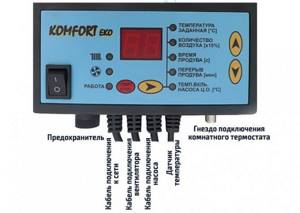
Automation connection diagram using Komfort ECO as an example.
How to set up
The detailed setup algorithm also depends on the model and is always described in the instructions. In general terms, the setup implies the following procedure:
- Setting the temperature for turning on the circulation pump - allows you to turn on the pump not immediately, but when the coolant has already warmed up, it is necessary to prevent the formation of condensation (usually set to 50°C).
- Setting the desired temperature of the heating circuit or room air, depending on the model and controls.
- Setting the fan rotation speed (from 1 to 10) or selecting one of the automatic fan speed control modes. When setting the boost completely manually, you also need to set the parameters for the fan operating time and the frequency of its activation in combustion support mode.
- Adding fuel and igniting the boiler. Monitoring its operation and, if necessary, adjusting parameters.
In some models, you can also program operation for a day or a week in advance, set a temperature threshold, after which the fan will begin to gradually reduce speed, etc.
Related Posts
- What is the need for and how does automation work on old-style gas boilers?
- Gas consumption from a gas holder for heating: how to calculate + tips for minimizing
- How to reduce the power of a gas boiler: the best options to reduce gas consumption by the boiler
- Thermal relay with remote temperature sensor: operating principle
- Connecting and calculating a buffer tank to a solid fuel boiler
- Remote control of the boiler: gsm, internet and other automation options
- Why does a gas boiler go out: what could be the reasons and what to do if it turns off
- Review of Rinnai gas heating boilers
- Turbocharged or atmospheric gas boiler? which one should I take?
- How to correctly calculate the power of a gas boiler
- Overview of the model range and types of temperature relays
- Combined heating boilers with wood and gas
- How to choose a wood-electricity combi boiler
- Uninterruptible power supplies for heating boilers of any type
- Household gas analyzer. household gas analyzers for apartments with gas stoves. wireless gas leak sensor with valve
- The best electric boiler for heating a home according to customer reviews
- The operating principle of a double-circuit gas boiler. classification and advantages
- Types and principle of operation of a gas boiler for heating a private house
- Ariston double-circuit gas heating boilers
- Gas in an apartment: safety rules, signs and consequences of a leak, harm to the body
- Hydroarrow: principle of operation, purpose and calculations
- Boiler Don 16 technical specifications
- How to test an electric motor with a multimeter
- Why gas burns with a red flame on the stove: factors affecting the color of the flame
- A supply of hot water that is always at hand: how does an electric water heater for heating work?
Read with this
- What is the need for and how does automation work on old-style gas boilers?
- Gas consumption from a gas holder for heating: how to calculate + tips for minimizing
- How to reduce the power of a gas boiler: the best options to reduce gas consumption by the boiler
- Thermal relay with remote temperature sensor: operating principle
- Connecting and calculating a buffer tank to a solid fuel boiler
- Remote control of the boiler: gsm, internet and other automation options
- Why does a gas boiler go out: what could be the reasons and what to do if it turns off
- Review of Rinnai gas heating boilers
- Turbocharged or atmospheric gas boiler? which one should I take?
- How to correctly calculate the power of a gas boiler
Installation and configuration
The installation process of an automatic control system includes:
- Connection of the blower fan. As a rule, the turbine is located on the lowest door of the boiler, where the damper is located. But there are models of units where it is installed on the side wall, or in a special place on the top of the boiler, it all depends on the design features. Everything is simple here: the damper is removed, and a fan is put in its place; four bolts are used for fastening. If there are no holes for mounting, they need to be drilled. For fans with a damper, installation is carried out in such a way that the damper is closed when the fan is off.
- Installation of the controller. First of all, you need to decide on the place where the device will be installed. The main requirement is that it should not heat up. On models without a hob, the automation is mounted on top. If the design of the unit allows, you can install the unit on the side wall. Don't forget about the length of the cables.
- Connecting the temperature sensor. A correctly installed temperature sensor will ensure the normal functioning of the entire control unit. If the model does not have a special place for the sensor (hole parameters: diameter 10 mm, depth 60 mm), then it can be mounted on the output metal pipe. A clamp is used as a fastening material; it can be supplied with the device.
- Connecting connectors. To do this, you need to connect the turbine connector to the control unit connector. Finally, you need to connect the device’s network cable. The automation is ready to perform its functions.
Air
- Manufacturer: Ukraine;
- Power supply: 220V/50Hz;
- Connected pump power: up to 450W;
- Fan power: up to 220 W;
- Coolant temperature setting range: 40-85oC;
- Temperature measurement accuracy: 0.1°C
- Room temperature setting range: 20-45oC;
- Estimated cost: 3000-3500 rubles.

Compact automatic control unit for solid fuel boilers. Allows installation and control of a powerful circulation pump and fan with a corresponding load current of 2 and 1 ampere; the modification allows load currents of up to 5A.
- Manufacturer: Poland;
- Power supply: 220V/50Hz;
- Connected pump power: up to 200W;
- Fan power: up to 200 W;
- Coolant temperature setting range: 30-80°C;
- Temperature measurement accuracy: 1°C;
- Room temperature setting range: 20-45oC;
- Manual target temperature setting and circulation pump control.
- Estimated cost: 6500-7250 rubles.
Connecting the heat accumulator to the heating system
As a general rule, the buffer tank is connected to the heating system in parallel to the heating boiler, therefore this circuit is also called a boiler piping circuit.
Let us present the usual diagram for connecting a heating unit to a heating system with a solid fuel heating boiler (to simplify the diagram, shut-off valves, automation and control devices and other equipment are not indicated on it).
Simplified wiring diagram for a heat accumulator
This diagram identifies the following elements:
- Heating boiler.
- Thermal accumulator.
- Heating devices (radiators).
- Circulation pump in the return line between the boiler and the heat exchanger.
- Circulation pump in the return line of the system between heating devices and heating equipment.
- Heat exchanger (coil) for hot water supply.
- Heat exchanger connected to an additional heat source.
One of the upper pipes of the tank (item 2) is connected to the boiler outlet (item 1), and the second is connected directly to the supply line of the heating system.
One of the lower pipes of the heat pump is connected to the boiler inlet, and a pump (item 4) is installed in the pipeline between them, ensuring the circulation of the working fluid in a circle from the boiler to the heat pump and vice versa.
The second lower pipe of the TA is connected to the return line of the heating system, in which a pump is also installed (item 5), which ensures the supply of heated coolant to the heating devices.
To ensure the functioning of the heating system in the event of a sudden power outage or circulation pumps failure, they are usually connected in parallel to the main line.
In systems with natural circulation of coolant, there are no circulation pumps (items 4 and 5). This significantly increases the inertia of the system, and at the same time makes it completely energy independent.
The heat exchanger for DHW (item 6) is located in the upper part of the heat exchanger.
The location of the additional heating heat exchanger (item 7) depends on the type of incoming heat source:
- for high-temperature sources (heating elements, gas or electric boiler) it is placed in the upper part of the buffer tank;
- for low-temperature ones (solar collector, heat pump) - in the lower part.
The heat exchangers indicated in the diagram are optional (items 6 and 7).
Operating principles of boilers with automation elements
Around this structural element there is a water jacket, which is heated by the hot walls of the fuel. Subsequently, water enters the pipes and radiators. In this case, the liquid circulates by gravity without any special pumps.
You can regulate the combustion intensity of a solid fuel boiler manually, using a damper, or using mechanical dampers. If you want to increase the temperature in the room, you need to raise the damper, which will increase air access and speed up the combustion process.
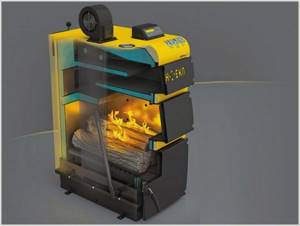
Automatic multiblocks
Scientific and technological progress today gives us the opportunity to use devices that are compact in size but have great functionality. Automation of gas boilers has not been left behind. Today, manufacturers offer multiblocks, which include:
- Combination type gas valve.
- Thermostat.
- Thermal sensor.
- Traction sensor.
- A device that stabilizes gas pressure.
- Burner valve. Typically this device has a two-stage action.
Pay attention to the first valve. It works in conjunction with a thermostat, which, using a temperature sensor, controls the temperature of the coolant directly in the heating circuit
Such a miniblock can work in tandem with a thermostat that is installed in the room. The latter controls the air temperature, and accordingly the temperature regime of the house. This connection helps to more accurately adjust the operation of a gas heating boiler.

